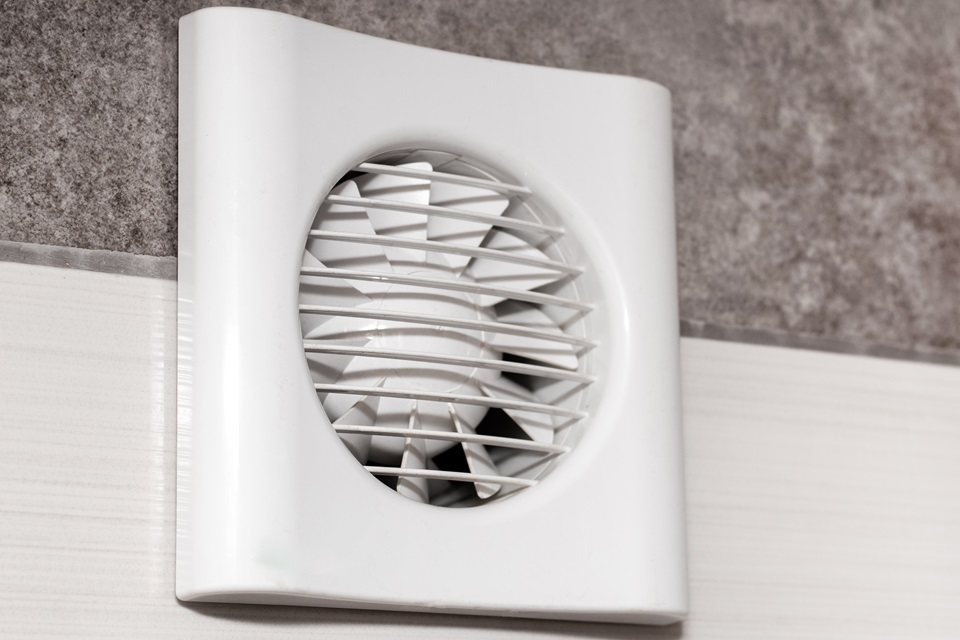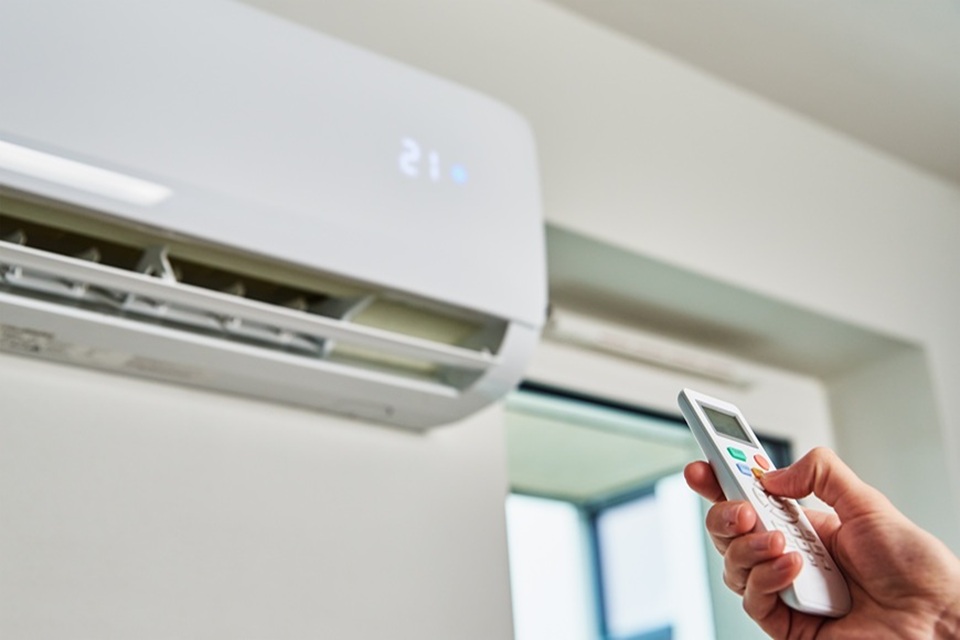How Much Does it Cost to Install an Extractor Fan?
You mainly use extractor fans in bathrooms and kitchens to remove odours and excess moisture from the air. They reduce condensation, which, in turn, stops mould from forming. In a kitchen, they eliminate steam, grease and odours.
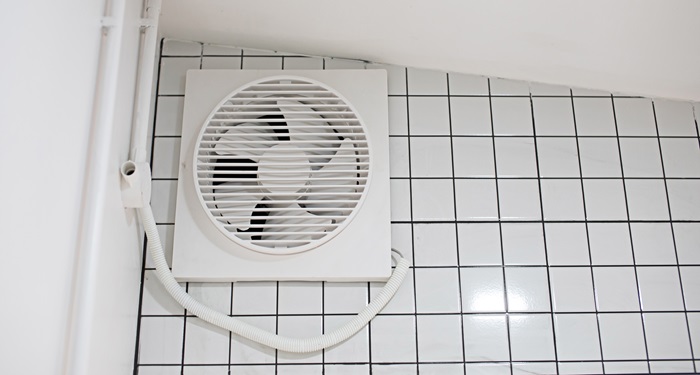
Our guide includes information about the type of extractor fans you can buy, the features to look out for, and the tradesperson’s installation costs. We will also give you an idea of any additional costs you need to take into consideration.
The average cost to install a standard wall extractor fan with a small amount of ducting in an easy-to-access location is £120
What is the Cost to Install an Extractor Fan in?
In the UK, the average cost for installation is between £60 and £120 for a simple 1-or 2-hour installation. A complex job that takes between 4 and 8 hours will cost between £240 and £480. Complex jobs usually involve ducting up into a loft or roof space or carrying out an installation in a location that’s hard to access.
An extractor fan should last between 5 and 15 years, depending on the manufacturer. Most come with a 2-year guarantee.
Extractor Fan Prices
The cost of an extractor fan will depend on the type of fan you need. A standard wall fan will cost between £20 and £50. However, if you’re looking to install an inline fan, you will be paying between £50 and £100. Prices will also be influenced by any additional features, such as the number of speed settings or the inclusion of a timer.
| Type of Fan | Average Price |
|---|---|
| Wall Fan | £20 - £50 |
| Window Fan | £40 - £70 |
| Ceiling Fan | £30 - £55 |
| Centrifugal Fan | £40 - £90 |
| Axial Fan | £20 - £80 |
| Inline Fan | £50 - £100 |
Another type of extractor fan used in the kitchen is a cooker hood. Cooker hoods are often placed on a wall over a hob like a chimney or under a cabinet. Island hobs will make use of extractors placed in the ceiling.
The price of a cooker extractor will depend on the model and its features. Average prices range from £75 for a standard model to £2,400 for a top-of-the-range model.
Small kitchens are ideal for downdraft extractors. They can be fitted within an induction hob or fitted underneath a worktop to save space. These extractors take away steam, smoke and grease from the kitchen.
It is removed through an external ducting system to the outside, or it is purified and recirculated. You can expect to pay between £500 and £1,500 for this type of kitchen extractor fan.
- What are the Supply Costs for Extractor Fan Installation?
- What are the Additional Costs of Installing an Extractor Fan?
- Tradesperson Costs for Installing an Extractor Fan
- Installing a Bathroom Extractor Fan in a Wall
- How Long Does it Take to Install an Extractor Fan?
- Where Do You Put an Extractor Fan?
- Types of Extractor Fans
- FAQs
- Sources
What Features Should I Look For?
Cheaper extractor fans don’t normally include any extra features. But more expensive options offer different features that include:
Humidistat
A fan with a humidistat has a sensor built into it which detects the level of humidity in the room. If the level reaches a set amount, the fan will turn on automatically. This feature is included in fans from around £60, but you can pay as much as £300. The average price is around £100.
Integral PIR (Passive InfraRed) sensor
This sensor detects movement and then switches on the extractor automatically. It’s a good solution for people who might forget to turn the fan on or if you don’t have an ideal location for a switch.
Timer
A timer on your extractor fan will mean the fan carries on working for a set amount of time after the light has been turned off.
Pull Cord
A pull cord allows the user to turn the extractor fan on manually.
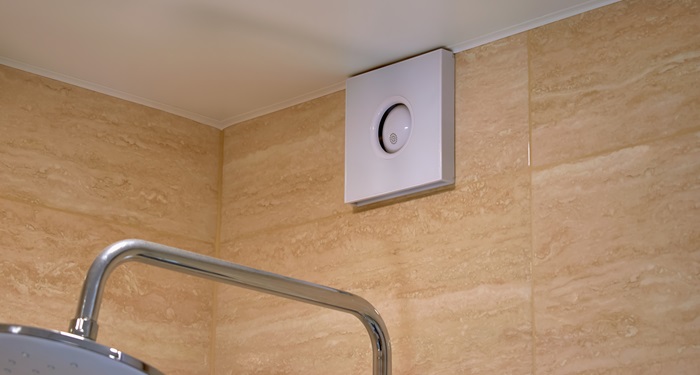
Automatic Shutter
An extractor fan with an automatic shutter will open when the fan is in use and then close again when the fan is turned off. This means cold air doesn’t get into the room from the outside.
Noise Level
Cheaper extractor fans may be noisier than more expensive options.
For example, you can buy a standard bathroom extractor fan with a single speed and a noise level of 41dBA for around £15. But if you want a standard 2-speed extractor with a noise level of 34dBA, then you’ll pay more at around £35.
The noise level of an appliance with a 35 dBA noise level is just above the sound of soft music playing. 41 dBA is the noise your computer fan makes. 20dBA is the noise level of a whisper.
Cost of Use
Look out for the amount of watts the extractor fan uses, as this will influence the running costs. Cheaper fans may have higher wattage ratings, so it costs more to run.
Here are some examples of an extractor fan price for fans that have the above features:
| Kitchen or Bathroom Fan | Average Price |
|---|---|
| Fan with Timer | £50 - £180 |
| Fan with Humidistat | £65 - £160 |
| Fan with shutter | £75 - £125 |
| Fan with cord | £33 - £55 |
| Fan with PIR | £65 - £220 |
| Window conversion kit | £35 - £50 |
What are the Supply Costs for Extractor Fan Installation?
Here’s a chart with the average price you can expect to pay for each extractor fan fitting cost with an electrician that charges an average of £50 an hour.
Extractor Fan Installation Cost
| Type of job | Job Duration | Labour Cost |
|---|---|---|
| Replace an existing fan | 1-2 hours | £50 - £100 |
| Installation of new fan, wiring and ducting through a wall | 6 hours | £300 |
| Installation of new fan, wiring and ducting through the ceiling into the roof space and out of an external wall | 1-2 days | £400 - £800 |
| Installing a window fan | 1 day | £400 |
| Installing a new fan with wiring and ducting through a wall over the shower in the bathroom | 5 hours | £250 |
What are the Additional Costs of Installing an Extractor Fan?
Depending on what type of fan you buy, you may also need ducting and a window kit if you want to install the fan into a window. Ducting costs from £5 for one metre to £25 for 10 metres. Insulated ducting is more expensive. On top of that, you might need clamps and a grille, which will cost between £13 and £19. Window kits cost, on average, between £30 and £44.

Other additional costs could relate to how the electrician gains access to your loft or roof space. If they need to erect scaffolding or a tower, then you could be looking at between £65 to £120 for one or two days of hire of a scaffold tower.
You might also incur additional costs if you are installing an extractor fan as part of a new bathroom or adding a sauna or a new kitchen. Here’s an idea of the average costs of this type of work.
| Room Installation | Average Costs, including installation |
|---|---|
| Small Bathroom | £2,750- £3,000 |
| Medium Bathroom | £4,500 - £7,000 |
| Large Bathroom | £7,000 - £10,000 |
| Small Kitchen | £2,500 - £4,000 |
| Medium Kitchen | £4,350 - £6,850 |
| Large Kitchen | £6,700 - £10,700 |
| Sauna for 2 people | £3,000 - £5,000 |
In the kitchen, you also need to add the costs of appliances, which can include:
| Appliance | Average Cost |
|---|---|
| Fridge/Freezer | £140 - £4,500 |
| Hob | £75 - £2,400 |
| Oven | £160 - £1,700 |
| Cooker Hood | £50 - £720 |
| Dishwasher | £250 - £1,400 |
| Microwave | £50 - £1,100 |
Tradesperson Costs for Installing an Extractor Fan
Most householders will ask an electrician to install an extractor fan. Bathroom installations will need to be signed off by a professional electrician in order to meet building regulations. An electrician who is registered under the competent person scheme will be able to sign off the work without the need for a building regulation inspection.
The costs for an electrician to do the work will depend on your location. Electricians based in London and the South East of England will often charge more per hour than electricians in other parts of the UK.
The average hourly rate is between £45 and £60 per hour, with day rates between £280 and £600. But in London and the South East of England, hourly rates may be between £75 and £85 an hour.
A two-hour extractor fan installation will typically cost between £90 and £120 plus travel time. Half a day will cost between £180 and £240.
Other trades that might be involved in an extractor fan installation also include a builder who will make the access for the venting and ducting through the roof. A builder will charge, on average, between £20 and £40 an hour.
HVAC technicians can also fit extractor fans. You may find that they will charge a similar price to an electrician at between £40 and £60 per hour.
Installing a Bathroom Extractor Fan in a Wall
When an electrician installs a bathroom fan, he will use the following materials:
- Saw
- Hammer
- Chisel
- Screwdriver
- Tape measure
- Drill and bit
- Grill
- Stud finder
- Fittings
- Ducting
The first job will be to make sure there are no wires or piping in the wall by using the stud finder. If the wall is clear, choose the location of the fan and draw around the edge of the fan. It will normally be square or circular. Using a drill, the electrician will create a series of holes around the drawing. They will then create a hole using a hammer and chisel to chop out the wall.
Next, it is time to fit the ducting, and once this is in place, the plasterwork can be repaired if necessary.
The third step is to fit the fan. This goes over the ducting and is secured with screws. This is done on the inside and outside walls.
The electrician will then wire up the extractor. This can be done by connecting the wiring to the light switch or to a separate control.
The final job will be to place the grille covers in position and test the installation.
How Long Does it Take to Install an Extractor Fan?
The time it takes to install an extractor fan depends on the complexity of the work. A simple wall fan, for example, might only take a couple of hours to install. However, if you have a fan installed with a lot of ducting or the installation is awkward to carry out, then an electrician might take up to a day to complete the work.
Where Do You Put an Extractor Fan?
You can put an extractor fan on a wall, on the ceiling or into a window cavity. But there are rules about extractor fans in bathrooms. Building regulations split a bathroom into three zones. Zone one is the area above the bath or in the shower area. Zone two is within 60cm from zone one in all directions. Zone three is anything outside zones one and two.

You can install any type of fan in your bathroom, but you must make sure the fan’s IP rating (international protection) is correct for its location. For example, if you want to install an extractor fan above the bath or shower tray (zone one) or anywhere in zone two, then it must have a minimum IPX4.
Wall Fan
Wall fans, as the name implies, are mounted on the wall of either a kitchen or bathroom. The vent is placed into the wall, and then ducting is installed through the exterior. It takes away steam and odours, which are pulled from the room and into the air outside.
Window Fan
A window fan is designed to be installed into a window using a conversion kit. The cost of installation may be higher because you will normally require the services of a glazier to fit a new window pane with an opening for the extractor.
Ceiling
A ceiling fan is often installed in larger rooms where more power is needed. It is secured to the floor of your loft space with a vent in the bathroom ceiling. It is then ducted through the roof or an outside wall.
Types of Extractor Fans
There are a number of different types of extractor fans. Here’s an explanation of each type, together with its pros and cons:
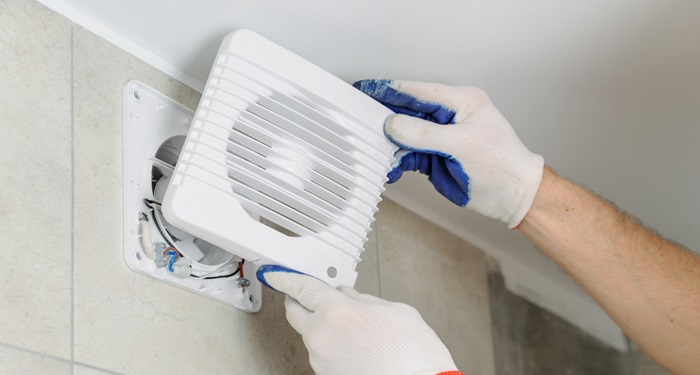
Axial Fan
Axial fans are usually connected to an external wall, so they aren’t moving the air around from a long distance. The fact that they are installed to cover short distances means that they don’t need powerful fan mechanisms.
Pros
- Reasonable cost
- Less energy consumption than other types
- Easy to install
Cons
- Can be noisy
- Not recommended if ducting needs to be installed over a large distance through lack of power
Inline Fan
Inline fans don’t go on walls or ceilings. They are installed in the loft space above the kitchen or bathroom ceiling. They are generally used because they have more power than other extractor fan types. They can also be ducted over long distances.
Pros
- Ideal if ducting long distances
- Higher pressure
- Energy efficient
Cons
- More expensive than other fans
- More work is needed to install than an axial fan
- Needs regular cleaning to work efficiently
Centrifugal Fan
Centrifugal fans have a high-pressure output, and they are ideal for larger spaces. Despite their power, they aren’t too noisy, which makes them a good choice for a large residential area.
Pros
- Quiet operation
- High pressure maintained at a distance
- Energy efficient
Cons
- Installation can be complex
- Needs regular maintenance
- More expensive to buy than an axial fan
FAQs
Q: What size extractor fan do I need?
A: Bathroom extractor fans usually come in three sizes. They are 100mm, 125mm and 150mm. A small bathroom or kitchen will usually only need a 100mm extractor, whereas a large bathroom or a kitchen will benefit from a larger fan. A 150mm fan is also better in a large household where a family all use the bathroom to shower one after the other either in the morning or at night.
Another consideration when choosing an extractor fan is the extraction rate. This is measured in litres cubed per hour (m3hr). Building regulations state that a bathroom fan must extract a minimum of 54m3/h, and a kitchen fan should extract a minimum of 216m3/h. A cooker hood should extract 108m3/h.
You will find that most extractor fans exceed the minimum extraction rates. For example, if you want to know what the best extraction rate would be for the cooker hood in your kitchen, then you will need to multiply the kitchen height by the length and the width and multiply that figure by ten.
Let’s take a medium kitchen measuring 2.5 x 3.5 x 3.5. Doing the maths gives you a total of 30.62. Now calculate 30.62 x10, and you have 306.25. That means that your ideal extraction rate is between 306m3/hr and 307m3/hr.
Q: Can I install an extractor fan myself?
A: If you are a competent DIY electrician, then you can probably do the job. If you are replacing an extractor fan with the same model and using the existing ducting and wiring, it is likely that you can do the job yourself as long as you are sure the old writing is up to standard.
But if you are installing a bathroom fan, the work will need to be signed off by building control. This means you must notify them before the work starts and pay the relevant costs (normally between £200 and £300).
It is easier to hire a registered Part P electrician who can do the work and sign it off. They will notify your local Building Regs department, which will send you a registration certificate confirming that the work has been carried out according to the building regs standards.
If you do the work without notifying the relevant authority, you are risking a fine of up to £5,000.
If you are replacing an extractor fan with the same model and using the existing ducting and wiring, it is likely that you can do the job yourself as long as you are sure the old writing is up to standard.
Q: How much does it cost to run an extractor fan?
A: Extractor fans aren’t running all day, so generally, they don’t use a lot of electricity. Let’s take an average bathroom extractor, which costs around £50 and runs at 10 watts.
The average cost of electricity in the UK in 2024 is £24.50p per kWh. So, 10 watts running for an hour will use 0.01kWh per hour. This costs less than one pence an hour. If you run it all day, it would cost around 5 pence.
Running a cooker hood is slightly more expensive, but again, they are not used for long periods. A typical cooker hood with a 200-watt motor will use 5kW per hour, costing £1.12 for 60 minutes.
Q: Do extractor fans require regular maintenance?
A: Most fans need to be cleaned regularly. The wiring should be checked if the fan doesn’t seem to be working optimally. Cooker hoods contain filters which can be washed in warm, soapy water. They should be replaced with new filters according to the manufacturer’s instructions.
To clean an extractor fan, you’ll need a cloth and warm, soapy water. Always turn the power off before you begin cleaning. Remove the grille and soak it in the water while you clean the fan blades and around the inside of the unit.
Wash and dry the grille and replace it when it is completely dry. If you want to, you can also remove the motor and gently clean it using a vacuum cleaner.
Q: What does an extractor fan do?
A: Extractor fans draw out the moisture that’s in the air and push it through the installed ducting into the outside air. This will stop condensation from forming and reduce the risk of damp and mould. Kitchen extractors are also used to eliminate odours and grease from cooking.

